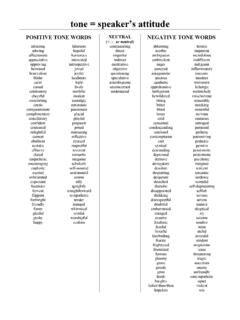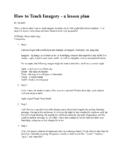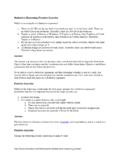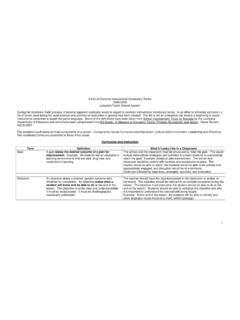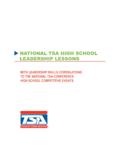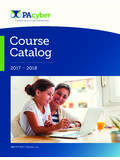Transcription of English Language Arts Targeted Tutoring Plan For …
1 English Language arts Targeted Tutoring plan For middle and High Schools Lafayette Parish Schools Developed in 2009-2010. Table of Contents Introduction .. 1. Research Findings .. 2. Procedures for Setting Up a Tutoring Program .. 3. Referral and Diagnostic Tools .. 3. Suggested Key Comprehension Skills for Explicit Instruction .. 4. Prioritized Sample Resources .. 4. Instructional Strategies: Ways to Build Confidence .. 4. plan for a 30-minute ELA Tutoring Session .. 5. plan for a 45-minute ELA Tutoring Session .. 6. plan for a 60-minute ELA Tutoring Session .. 7. High School Tutoring .. 8. References .. 9. Appendix: Tutoring Profile ..10. Edusoft Test Items for Each Key Comprehension Skill - middle School ..11. Edusoft Test Items for Each Key Comprehension Skill - High School ..12. Tutoring Progress Report ..13. English Language arts Tutoring Program Information Letter (sample) ..14. English Language arts Tutoring Program Consent Form (sample).
2 15. Focus Questions to Ask Before Reading ..16. Focus Questions to Ask During Reading ..17. Focus Questions to Ask After Reading ..18. How to Provide Useful Feedback ..19. Modeling the Think Aloud Process ..20. Introduction 1. ELA Targeted Tutoring : middle and High School Research Findings Findings from research indicate that Tutoring programs are successful when quality instruction is in place by professionals who are highly motivated and qualified in their area;. the Tutoring curriculum is aligned with the regular classroom curriculum;. group size is small; an ideal ratio is 1:5;. sufficient time is given for improvement; at least two hours/week for ten weeks is recommended;. the focus is on students who will really benefit (struggling readers);. the materials are at the students' independent level in initial instruction;. tutors use a Tutoring profile template to diagnose each student's skill levels and track the session-to-session progress of each student.
3 The focus of Tutoring is on skills that will transfer to content-area learning;. comprehension strategies are taught through explicit teaching with modeling and followed by guided practice;. independent readers realize that reading is thinking: dependent readers need someone to conduct think-alouds to model the reading/thinking process;. immediate, relevant and continuous feedback is used;. tutors communicate and collaborate with classroom teachers;. goal setting and tracking/discussion of progress are done individually between tutor and student and address student motivation;. parents are informed of the skills covered in Tutoring sessions; and use of computer programs is closely monitored, and printed reports are shared with students and used to track progress. Note: students should be monitored so they are not just clicking.. 2. Procedures for Setting Up a Tutoring Program 1. Identify individual areas of weakness and diagnose each student's level of mastery for key skills.
4 (See Referral and Diagnostic Tools below.). 2. Form small groups of students. Ideal size is five students per tutor. Choose students who score Unsatisfactory or Approaching Basic on the LEAP/iLEAP, who are failing ELA, who are recommended by their teacher, who consistently underperform on Edusoft unit tests, or who score below average on the AIMS Web MAZE Comprehension test given in all middle schools. Data triangulation will help to prioritize students for Tutoring . 3. Choose tutors who are highly motivated and highly qualified in their area. 4. Contact students and parents with information about Tutoring dates and times. (See sample letter and consent form in the Appendix.). 5. Collect data on each student using the Tutoring Profile. (See Appendix.). 6. Tutors and students should discuss goals, and tutors should build confidence from the beginning. (See Ways to Build Confidence in this document.). 7. plan Tutoring sessions to include fluency, vocabulary, and comprehension building, as well as writing.
5 (See Plans for 30-, 45-, and 60-minute Tutoring sessions. ) Use focus Use focus questions to guide students in beginning, during, and after learning activities. 8. Use a structured program. Have a list of key skills students need to be successful readers (See Suggested Key Comprehension Skills for Explicit Instruction. ) Use explicit instruction and modeling. A think-aloud model is included in the Appendix. 9. Monitor student progress and give feedback frequently. (See How to Provide Useful Feedback in the Appendix.) Use a reporting form such as the Tutoring Progress Report to communicate with classroom teachers. (See Appendix.). 10. Have students write what they have learned at the end of each session and monitor their own progress from session to session and over time. Note: Use Tutoring Adolescent Readers as a reference for implementing Tutoring . Referral and Diagnostic Tools 1. LEAP/iLEAP scores can be used to identify students who need Tutoring .
6 2. (for middle schools) AIMS Web MAZE Comprehension is given to all middle school students to access levels of comprehension. The subsequent administration of the test at mid-year can be used for assessing growth. AIMS Web Fluency can additionally be given to students who do poorly on the comprehension test. The directions, norms and passages can be found on the AIMS Web internet site. 3. Edusoft test print labels for each unit list the concept areas needing attention (Grade Level Expectations). To access them, go to Assessments on the Edusoft website, choose an assessment and print labels for each student. 4. Edusoft constructed response results provide information on ability to analyze and respond to text. 5. ELA report card grades and teacher recommendations identify students who are performing poorly for extra help. 6. Three-Minute Reading Assessments: Word Recognition, Fluency & Comprehension for Grades 5-8 (Scholastic publication) can be used for further diagnosis and tracking of progress.
7 3. Suggested Key Comprehension Skills for Explicit Instruction 1. Predicting 2. Finding the main idea 3. Making inferences and drawing conclusions 4. Asking questions 5. Determining author's purpose 6. Paraphrasing and summarizing 7. Comparing/contrasting ideas (Note: Edusoft test items linked to these skills are listed in the Appendix.). Prioritized Sample Resources 1. Department of Education LEAP Tutoring lessons 2. Louisiana PASS - 3. EAGLE (individual skills) - 4. LEAP/GEE practice tests - and LEAP/GEE/iLEAP assessment guides - ;. and 5. Project LiFT materials 6. LEAP/GEE/iLEAP preparation booklets (such as Buckle Down or Options). 7. Achieve 3000. 8. NovaNet (individual skills). 9. Classroom texts for English , science, and social studies 10. Kelly Gallagher's newspaper Article of the Week archive on his website at (high school). 11. New York Times front page articles: Instructional Suggestions: Ways to Build Confidence Accept students where they are.
8 Get to know each student as a person. Start at a comfortable reading level for the individual. Comment on each student's strengths during instruction. Offer praise specific to attainment of skills. Stay positive, paying attention to your own body Language , facial expression, and tone of voice. Relate to students' lives by helping them make connections to their reading. Compare progress of each student to himself, not against other students. Remind students of growth as Tutoring sessions evolve. 4. plan for a 30-minute ELA Tutoring Session After analyzing student performance data and conferring with classroom teachers, determine the order of skills to be taught and gather materials for the Tutoring session. Fluency (5 minutes). Materials: shared text for students and teacher 1. Read aloud a section of fiction or nonfiction text or a poem to students. 2. Discuss unusual words by asking student to predict meaning using the context of the text.
9 Individual white boards for vocabulary (in both fluency and comprehension instruction) are good tools for the kinesthetic learners. 3. Follow with echo reading (where teacher reads and students reread), impress reading (where teacher and students read text aloud together), and/or choral reading (where group and individual parts can be assigned). 4. Because of time limitations the same text can be used in these various ways for several Tutoring sessions. Comprehension (25 minutes). Materials: shared text for students and teacher 1. Introduce fiction or nonfiction selections by previewing and scanning the text with students. Refer to Focus Questions to Ask Before Reading in the Appendix. Literary pieces used to teach the identified skills can be content area texts, texts from supplemental sources, or real-world texts such as newspaper or magazine articles. (High school tutors may want to utilize Kelly Gallagher's newspaper Article of the Week archive on his website at Gallagher also provides questions that correspond to each article.)
10 The skills necessary to be a good reader are embedded in the questions.). 2. Describe for students each skill that will be used in the session. Name the skill and discuss when and how it should be used. 3. Model the process for using the skill by reading text and doing a think-aloud showing the skill in action. 4. Have students use and discuss the process on a section of text collaboratively with you and other members of the group. 5. Provide guided practice on the skill by having students use the skill in groups of two or three followed by discussion. 6. After a few sessions, give students an opportunity to practice the skill independently. 7. Follow up with writing related to the skill and text. Time limitations in the 30-minute session may necessitate that writing be done in a subsequent session. Note: The same instructional pieces can be used for several Tutoring sessions. Rereading text from a previous session is a chance for students to read familiar text and build fluency.
